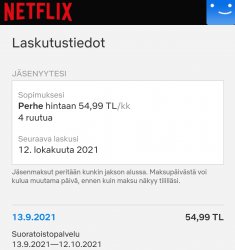Eilen tuli puolihuolimattomasti testattua tämä aiemmin keskusteluttanut Turkki-kikkailu, jolla sai UHD-sopparin n. 5,6e / kk.
- Pohjalla vanha normaali Suomi-tili, joka ollut tauolla muutaman kuukauden. Tilillä tallessa maksutiedot, puhelinnumerot yms.
- VPN-yhteys Turkkiin (NordVPN, 7 päivän trial)
- Netflix-sovelluksen kautta sisään ja tilaus uusintaan (UHD hintaan 54,99 TL / kk), ei kikkailuja, ei ongelmia
- VPN poikki, poistoon ja triali peruutukseen
- Netflix toimii normaalisti ilman kikkailuja ja sopparin tiedoissa hinta on tuo 54,99 TL toistaiseksi
En ota kantaa homman moraalisuuteen, mutta omalla katselukäyttäytymisellä Suomihinta oli kynnyskysymys.

Jos moraalisuus mietityttää, lopputulos on sama jos sattuu Turkin reissulla aktivoimaan Netflixin..

 Luulin aiemman keskustelun olleen vain pientä offtopiccia, mutta olipahan positiivinen ylläri meikäläiselle.
Luulin aiemman keskustelun olleen vain pientä offtopiccia, mutta olipahan positiivinen ylläri meikäläiselle.


